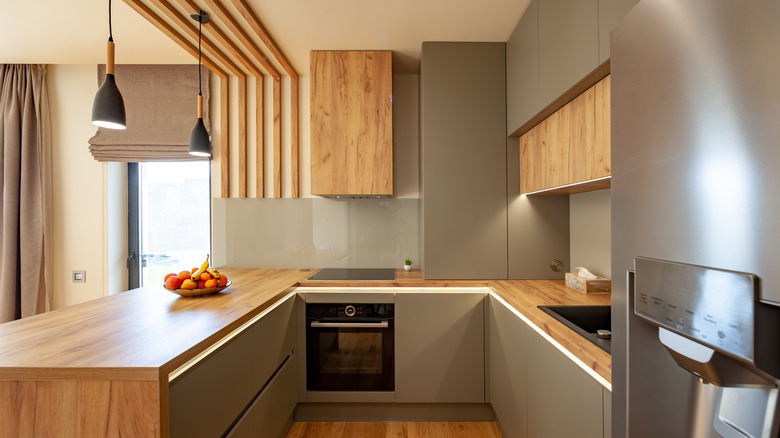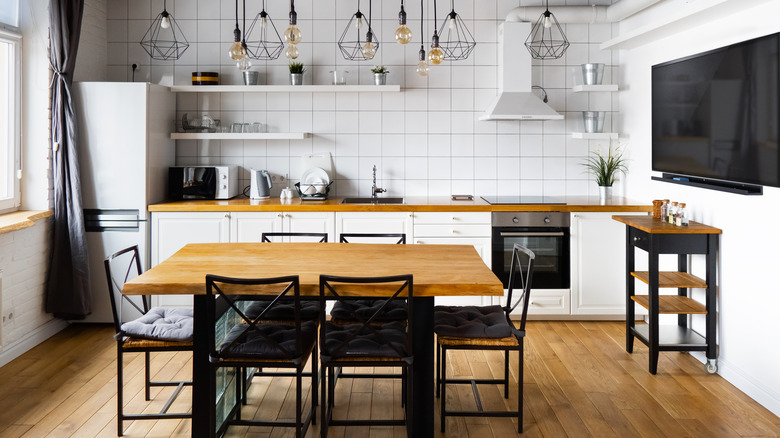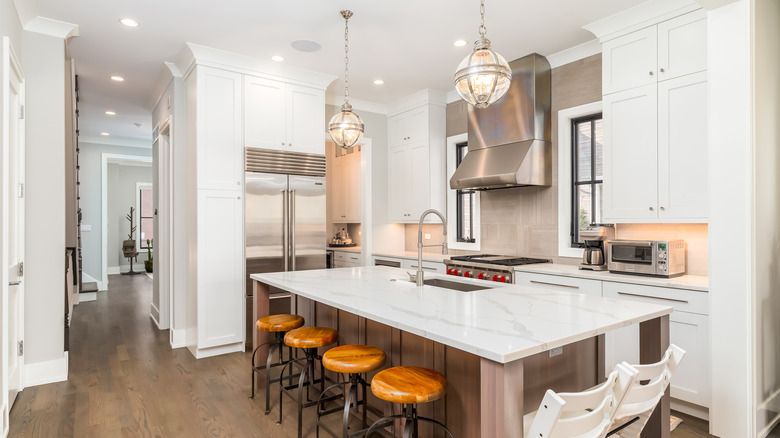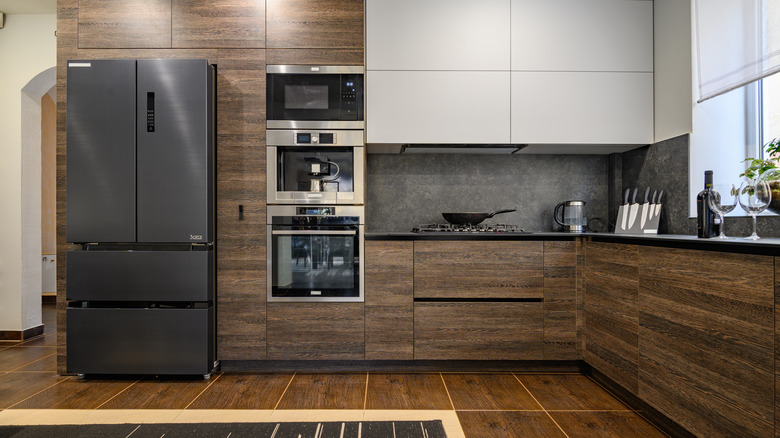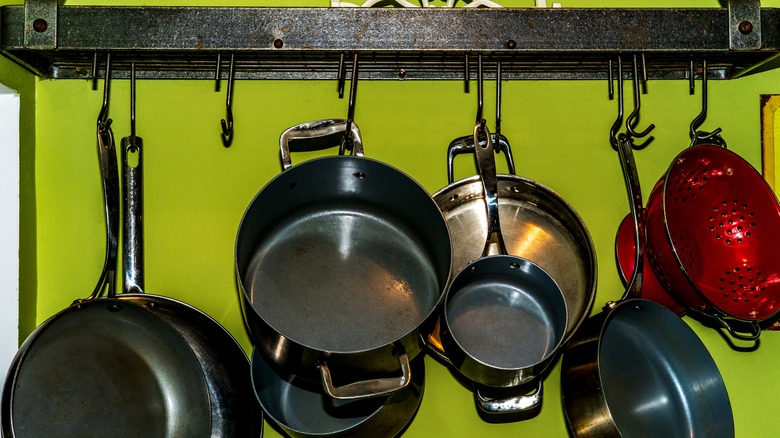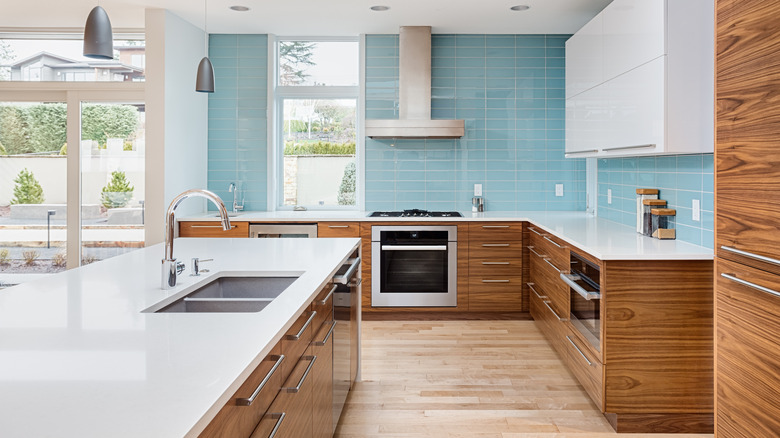5 Tips For Choosing The Right Style Kitchen To Match Your Home's Aesthetic
We may receive a commission on purchases made from links.
Think about how we differentiate a house from a home. One of the best giveaways is that in the latter, you can appreciate the actual homesteading taking place. You see the way roots are being put down, and you can observe that by taking in the homeowner's approach to aesthetics. You witness firsthand the forethought that goes into their design choices. In turn, the ideas behind those designs reveal the personalities of those living there.
So when you're mulling over what your ideal kitchen should look like, you should take a holistic approach. It's not just a room where meal preparation takes place, but an environment where you plan, organize and create the food that keeps your family thriving. More than meals, says Realtor, you're making memories here, too.
So before you even begin, consider what you want to accomplish in your kitchen. Are you someone who truly enjoys the process of cooking, or are your needs more basic and simple? Do you entertain? How much time of any given day will you be spending here? Is this meant to be a family hub, whether people gather and visit while meal prep is in progress? If that's the case, think about foot traffic. Will you be happier with more stone, more wood, or more metal furnishings? All of these factors should be something of a compass. And the more time you spend here, the more your surroundings should be a delight to the eyes — especially yours.
1. Stay congruent
Your first tip is to stay congruent. Your kitchen is meant to reflect how you cook, how you eat, and what you like to see while preparing meals. But this room isn't a set on a Hollywood backlot, and it doesn't exist on its own. It's an integral part of the house and needs to look as though it's part of your entire home.
Inside and out, your entire residence should reflect your taste. And there's certainly ample wiggle room within any one style to allow for a lot of personal expression. But every room, kitchen included, ought to look like it belongs under the same roof. That means design ideas that lead in and out of your kitchen should be consistent and congruent — with clever little detours sprinkled throughout.
The designers at Monica Beatrice go into detail on this notion, and one of their best descriptors is that you should think of your home as your personal brand and consider what it is you want to say. You wouldn't put a farmhouse kitchen in a minimalist modern house, but you can make almost any environment lean in the direction of your style.
Reflect on the colors and textures you already like in other rooms — the floors, for example. Levi's 4 Floors provides a variety of ways to integrate (or separate) your kitchen and the rest of the house. Now expand that approach and include your walls, floors, and cabinetry.
2. Picking styles
The next tip is to pick a compatible style. By now, you should be either getting a clearer idea of the look you want to create in your kitchen or becoming more certain sure about what you don't want. You've taken a moment to assess your home and made decisions about what themes you'd like to be incorporated in your kitchen from the overall aesthetic of your home or the style in which you've already decorated.
So, let's familiarize you with the typical options for kitchen designs. Chances are that your home was built in keeping with one of these styles, which should inform you but not hamper your creative impulses in making your kitchen your own. KraftMaid explains that the most popular styles of kitchen cabinets are rustic, modern, contemporary, transitional, and traditional.
But if you have, for example, a pre-war house and you want to create a farmhouse kitchen or one that celebrates Art Deco design, a renovation may be necessary. Consider the work, the expense, and the time your kitchen could be out of commission. Remodels make the most sense for homeowners who don't mind the inconvenience because they'll get something they love that also enhances the resale value of their home.
You don't need contractors to effectively and economically transform your kitchen. And DIY projects allow you to keep both price and quality control at your fingertips.
3. Appliances, fixtures
Your third tip is to rethink your hardware and cabinet color combinations. By that, we mean everything from hanging lights to faucet fixtures and appliances. Now you get to decide (with both your tastes and budget in mind) how you want to proceed with your kitchen makeover.
Start by taking a look at different kitchen cabinet colors and different colored appliances. Once you get a sense of precisely how many elements are in play, take a deep breath. Yes, floors, walls, cabinets, and backsplashes are a lot to mentally juggle, but 50 Floor has a tutorial that can simplify and clarify how to proceed. If you follow their guide, you'll start with picking countertops, then pick two dominant colors you want to emphasize. Again, either of these could be carried through from the entryways to the kitchen to unify and ground the design in the rest of the home, or they could work in tandem with the colors of the walls, floors, or major appliances. They also caution not to make decisions based on color alone but to consider the compatibility of textures as well.
When you replace, remove or paint something, it can affect the entire space. 50 Floor advises doing these things mindfully so you'll not only have a more harmonious and inviting kitchen, but you could end up with a space that looks larger than it did before.
4. Think storage
Tip number four might not be one you'd think of offhand. It's everything you do and don't see when you walk into a kitchen. Not surprisingly, people weigh in across the spectrum on this topic. Some people like every possible thing out of view, others don't mind a can opener, crock pot, or coffee maker out on the counter, and others want all their cookware dangling from overhead. It's all a matter of style.
If you're someone who always has something on the stove or in the oven, you might be feeling pretty saucy about that saucepan and want to show it off. Having cookware visible is tangible evidence that there's someone in the house who loves to cook, and it's an expression of creativity and confidence that is an aesthetic all its own. Pot and pan racks do add a real luster of life at home, too, especially over a median or countertop. You won't have any trouble finding these pot and pan racks everywhere, from Bed Bath & Beyond to Amazon and elsewhere.
At the other extreme, you'll find hidden kitchen designs that, if not always the most practical, are aesthetically not much short of breathtaking. And while you might think that hiding every single thing a kitchen contains is kooky, just wait until you see the effect (per These Three Rooms).
5. Leave room
Your last tip may be the most important. If you're looking to redo your kitchen, you don't want it cluttered with stuff — even if that stuff is state-of-the-art or just out of the box. You'll want your kitchen to have some growing room, and you should consider decluttering your space of all the junk you never use.
There's much finger-wagging on this topic. Ask Alpha Mom, and she'll admonish you to never put something down if you can put it away instead. Of course, that advice addresses the safety of young aspiring chefs working near items that could cause injury, as well as kids randomly racing through the kitchen. Even if you aren't planning a bigger family, keeping too many gadgets out can make your home feel cluttered. And the more clutter, the more germs, and the more stuff lying around, the less attractive. Also, if you're selling your house, clutter is kryptonite for prospective buyers. The Food Network says you should always avoid stacks of mail, memorabilia attached to your fridge, and disorganized cabinets and drawers.
Consider it ongoing advice: Having a countertop grill or a waffle iron is all well and good, but do you use them every day, like you would a coffee maker or toaster? Appliances that aren't in constant use can detract from the clean and open look that convinces most people they need a makeover in the first place.

